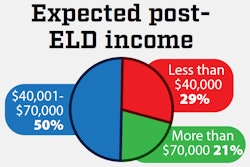 Though the number of hours of service violations has declined since the ELD mandate took effect, the number of truck crashes has not, particularly among smaller carriers — the segment of the industry that the researchers deemed most impacted by the mandate.
Though the number of hours of service violations has declined since the ELD mandate took effect, the number of truck crashes has not, particularly among smaller carriers — the segment of the industry that the researchers deemed most impacted by the mandate.A group of researchers this month issued a report on the effects of the electronic logging device mandate, and they reached two main conclusions: The use of ELDs has not reduced the rate of truck crashes, but it has increased the frequency of speeding violations, particularly among the small carrier segment.
Speeding violations, the report concludes, follow behavioral changes driven by ELD adoption as truckers try to make up for productivity losses.
The report mostly focuses on smaller carriers, such as independent owner-operators, whom the researchers deemed most impacted by the mandate. Many larger carriers, it assumes, already had been using ELDs (or predecessor automatic onboard recording devices) prior to the mandate’s December 2017 effective date.
Titled “Did Electronic Logging Device Mandate Reduce Accidents?” and published this month by researchers from Northeastern University and the University of Arkansas, the research report concludes that the mandate was effective in its goal of increased compliance with hours of service regulations. “However,” they write, “there is no evidence to suggest that the number of accidents decreased” as a result.
The researchers studied data on driver inspections and federally recorded crashes between January 1, 2017, and September 1, 2018, with the bulk of the data coming from the Federal Motor Carrier Safety Administration. They studied violations from 4 million inspections of 224,878 for-hire interstate carriers.

Unaccounted for in the study was any control for miles increases or decreases over the time periods, whether in trucks operated or miles driven by the motoring public with whom truckers share the roads. Instead, the research is simply based on weekly averages of violations and crashes. Also unaccounted for is crash fault, such as whether crashes were the fault of truck drivers or other motorists.
The percentage of total hours-of-service violations in sum fell from 6 percent (based on the number of inspections) to 2.9 percent in the mandate’s hard enforcement period, though much of that decrease in violations came from the small carrier segment, the research states. For independent owner-operators, the rate fell from 10.7 percent to 6 percent, while for drivers at larger carriers, the rates fell from 0.85 percent to 0.75 percent.
However, crash numbers saw little impact by the enforcement of the ELD mandate, despite fewer hours of service violations.
The January 1, 2017, to September 1, 2018, time period studied by researchers included nearly a year’s worth of data prior to the December 18, 2017, enforcement deadline of the ELD mandate, as well as the roughly three-month light enforcement period ahead of the April 1, 2018, hard enforcement date. It also included data from the five months after hard enforcement of the mandate began.
For the pre-enforcement period, researchers said there was an average of 1,717 truck crashes a week. That number spiked during the soft enforcement period (December 17, 2017, to April 1, 2018) to 1,912 crashes a week. After April 1, the number dropped to an average of 1,703 crashes per week.
Of note for smaller carriers, despite being more likely to be hit with an hours of service violation, they were less likely to be involved in a crash than drivers at larger carriers. Independent owner-operators averaged 154 crashes a week prior to the ELD mandate December 2017 deadline and 160 crashes after hard enforcement began in April 2018. Drivers at carriers with between 101 and 1,000 truck averaged 374 crashes a week before the mandate and 361 crashes a week after hard enforcement began. Carriers with 1,001 or more trucks saw their crash rates dip slightly, from 244 a week to 240 a week.
Hours of service violations and truck crash rates mostly acted on a gradient, according to the numbers. The smaller the carrier, the higher the rate of hours of service violations, especially before the mandate. However, the larger the carrier, generally, the higher the crash rate — an inverse to hours of service violations.
Carriers with between two and six trucks averaged 242 crashes a week before ELD enforcement began and 247 crashes a week after hard enforcement began. Carriers with seven to 20 trucks averaged 254 crashes prior to the mandate and 261 crashes a week in the hard enforcement period. Carriers with between 21 and 100 trucks averaged 373 crashes a week pre-mandate and 369 crashes post.
What’s more, each of those segments (except for the largest of carriers) account for roughly the same number of power units, according to data from the Tucker Company Worldwide, meaning those raw weekly averages aren’t swayed by an outsized number of trucks for any one segment (except for carriers with 500 trucks or more, who account for nearly three times as many power units as the other-size segments).
“Collectively, these numbers do not point to any obvious reduction in accidents due to the ELD mandate, and in some cases suggest a possible increase in accidents for those carriers most affected by the mandate,” the researchers conclude in the study.
Relative to unsafe driving infractions — notably, speeding — hard enforcement of the ELD mandate caused the rate of infractions to spike across all sizes of fleets. Researchers attribute the increase in speeding and other unsafe driving violations to drivers attempting to make up for productivity lost to ELD adoption.
For independent owner-operators, the weekly average of unsafe driving violations jumped to 362 a week in the hard enforcement period, up from 268 violations a week prior to ELD enforcement — a 35 percent increase.
Carriers of other sizes also saw increased violation rates for unsafe driving, though not nearly as pronounced as independent owner-operators. For instance, carriers with between 101 and 1,000 trucks saw only a 6 percent increase in the number of unsafe driving violations per week after hard enforcement of the mandate began. Carriers with more than 1,000 trucks saw a 12 percent increase in unsafe driving violations after ELD enforcement began.
Unsafe driving violations for carriers with two to six trucks rose 17.5 percent; seven to 20 trucks rose 11 percent; and 21 to 100 trucks climbed 14 percent.
“We find that the ELD mandate unequivocally enhanced HOS compliance,” the researchers write. “However, the ELD mandate did not noticeably improve safety, and we are able to produce no statistically significant evidence that ELD adoption by the smaller firms corresponded to any reduction in accident rates.”
The researchers do note that ELDs have shown to be “correlated with reduced accidents at larger firms,” according to research conducted prior to the mandate.
Despite the apparent lack of safety benefits of the mandate for the time period studied by the researchers, they point to reduced paperwork, information availability to inspectors and carriers and pressure on shippers and receivers to be more efficient in cutting delays for drivers as “positive aspects” of the mandate.














